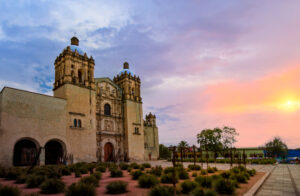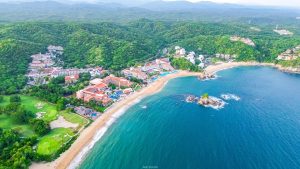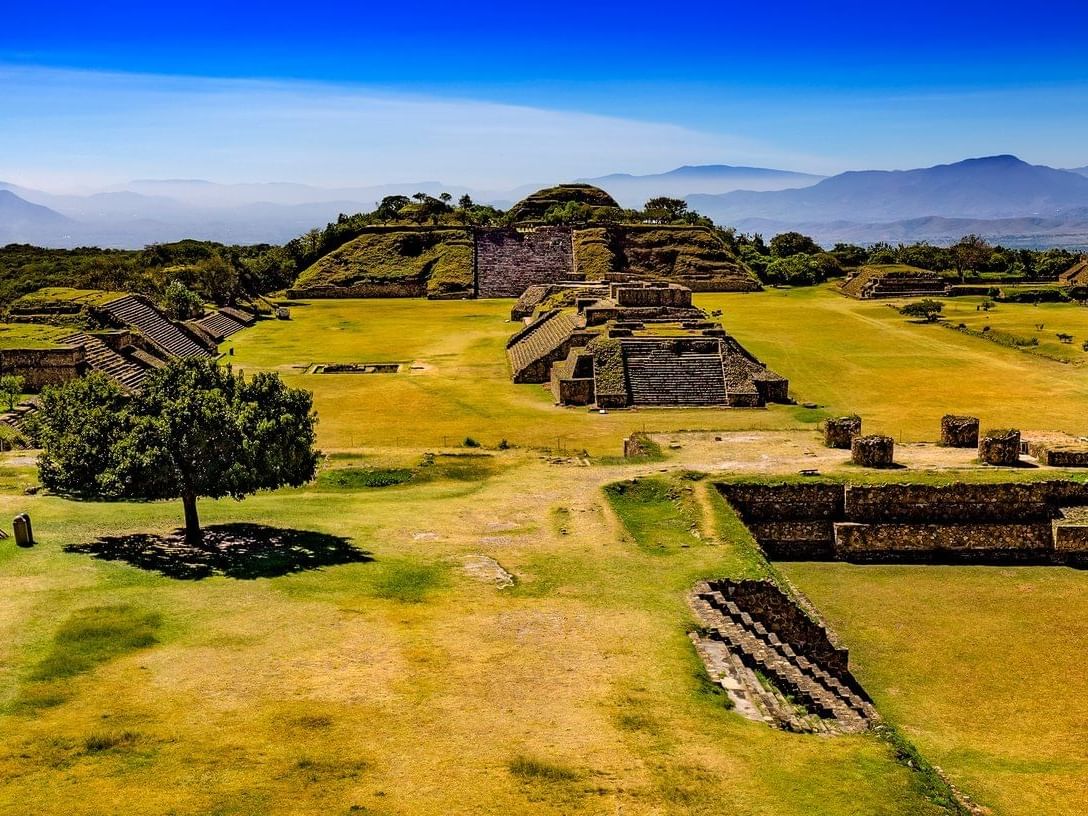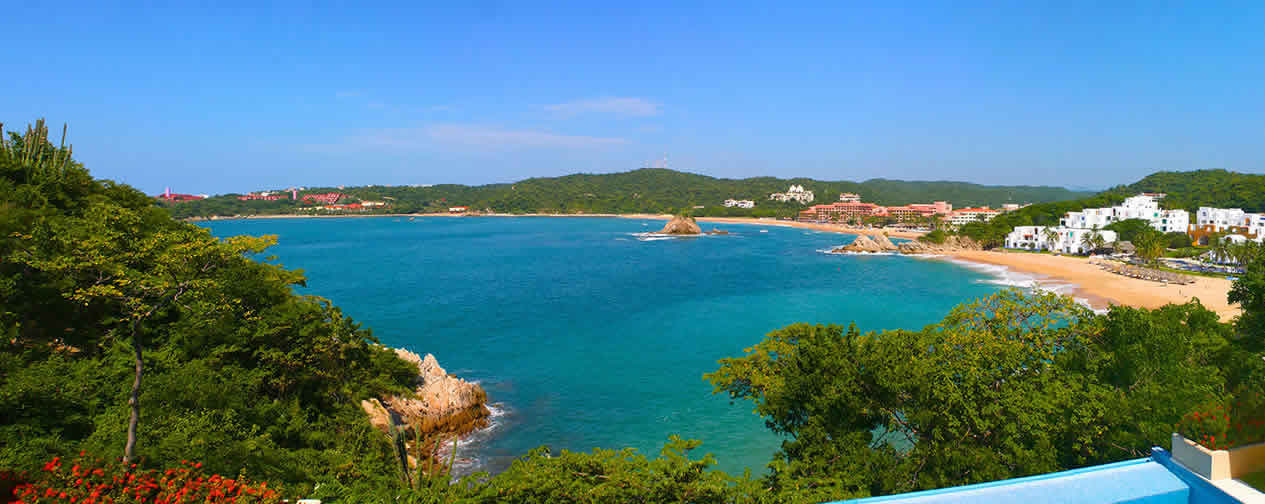- Overview
- Itinerary
- History
- Best Time
- Gallery
- FAQ
Oaxaca, a vibrant city in southern Mexico, is a cultural treasure trove renowned for its rich indigenous heritage, colorful traditions, and exquisite cuisine. Wander through the cobblestone streets of the historic center, a UNESCO World Heritage Site, and marvel at the architectural gems like the Santo Domingo Church and the Zócalo, the city's main square. Immerse yourself in the bustling atmosphere of the local markets, where you can sample regional delicacies like tlayudas, chapulines (grasshoppers), and mezcal, the smoky spirit of Oaxaca. Explore the nearby archaeological sites of Monte Albán and Mitla, remnants of the ancient Zapotec civilization.
Huatulco, a coastal paradise nestled on the Pacific coast, offers a tranquil escape from the city's hustle and bustle. Discover nine pristine bays, each with its own unique charm and character. Relax on secluded beaches, swim in crystal-clear waters, or embark on a snorkeling or diving adventure to explore the vibrant marine life. Indulge in fresh seafood at beachfront restaurants, or simply unwind with a cocktail and soak up the sun.
Together, Oaxaca and Huatulco offer a diverse and unforgettable experience, combining cultural immersion with natural beauty and coastal relaxation. Whether you're seeking a vibrant city break or a tranquil beach getaway, this dynamic duo has it all.
Mexico City, Oaxaca, and Huatulco Excursions (8 Days)
Day 1 (Saturday)
- Arrival in Mexico City, hotel check-in.
- Welcome meeting.
Day 2 (Sunday)
- 7:00 to 8:45 am: Breakfast.
- Chapultepec Castle tour.
- Walk through the historic area.
- Return to the hotel and rest.
- Preparations for the evening dinner.
Day 3 (Monday)
- 7:00 to 8:45 am: Breakfast.
- Pyramid Tour and Guadalupe Shrine.
- Lunch at La Gruta.
- Return to the hotel for dinner.
Day 4 (Tuesday)
- 7:00 to 8:45 am: Breakfast.
- Fly to Oaxaca.
- Arrive at the hotel and check-in.
- Dinner at the hotel.
Day 5 (Wednesday)
- 7:00 to 9:00 am: Breakfast.
- Board bus at 9:30 am for Oaxaca City tour.
- Lunch in Oaxaca.
- Stroll the main street for gift shopping.
- Return to the hotel for dinner.
Day 6 (Thursday)
- 7:00 to 9:00 am: Breakfast.
- Board bus at 9:30 am for Mitla and Tule Tree tour.
- Lunch at a local restaurant.
- Return to the hotel for dinner.
Day 7 (Friday)
- 7:00 to 9:00 am: Breakfast.
- Fly to Huatulco.
- Arrive at the hotel and check-in.
- Free afternoon to explore the beach.
- Dinner at the hotel.
Day 8 (Saturday)
- 7:00 to 9:00 am: Breakfast.
- Free day to enjoy the beach and local attractions.
- Dinner at the hotel.
Day 9 (Sunday)
- Breakfast and check-out from the hotel.
- Board ground transportation to the airport for the flight home.
History: Oaxaca & Huatulco
Oaxaca:
- Ancient Zapotec Civilization: The Oaxaca Valley was once the heart of the Zapotec civilization, a pre-Columbian culture known for its impressive architecture, intricate hieroglyphic writing system, and advanced agricultural practices. The ruins of Monte Albán, a UNESCO World Heritage Site, stand as a testament to their ingenuity and power.
- Mixtec Influence: The Mixtecs, another indigenous group, also left their mark on Oaxaca, particularly in the region's intricate gold jewelry and vibrant textiles. Their influence can be seen in the archaeological site of Mitla, known for its elaborate mosaics and geometric designs.
- Spanish Colonial Era: The Spanish arrived in Oaxaca in the 16th century, establishing a colonial city on the ruins of the Zapotec capital. They built grand cathedrals, monasteries, and government buildings, many of which still stand today.
- Cultural Melting Pot: Oaxaca's history is a rich tapestry of indigenous and European influences. This fusion is evident in the region's unique cuisine, art, and traditions, making it a fascinating destination for cultural exploration.
Huatulco:
- Pre-Columbian Era: Before the arrival of the Spanish, Huatulco was inhabited by various indigenous groups, including the Mixtecs and Zapotecs. They established small settlements along the coast and engaged in fishing, agriculture, and trade.
- Spanish Colonial Port: During the colonial era, Huatulco served as an important port for Spanish galleons traveling between Mexico and the Philippines. The bay's sheltered waters provided a safe haven for ships, and its strategic location made it a key center for trade and commerce.
- Pirate Attacks: Huatulco's prosperity attracted the attention of pirates, who frequently raided the port in the 16th and 17th centuries. The most famous of these raids was led by the English privateer Sir Francis Drake, who sacked the town in 1579.
- Modern Development: Huatulco remained a relatively isolated fishing village until the 1980s, when the Mexican government launched a major tourism development project. Today, it's a popular destination for beachgoers, nature lovers, and adventure seekers.
Together, the histories of Oaxaca and Huatulco offer a fascinating glimpse into the rich and diverse heritage of Mexico's Pacific coast. From ancient civilizations to colonial influence and modern development, this region's history is as captivating as its natural beauty.
Best Time to Visit Oaxaca & Huatulco
Oaxaca and Huatulco enjoy warm climates year-round, making them inviting destinations any time. However, certain seasons offer distinct advantages depending on your preferences and interests.
Oaxaca City:
- October to May: This is the dry season in Oaxaca, with warm days and cooler nights. It's the perfect time to explore the city's historic center, vibrant markets, and nearby archaeological sites without the discomfort of humidity and rain.
- July: If you're a culture enthusiast, consider visiting during the Guelaguetza festival, a colorful celebration of indigenous traditions with vibrant costumes, music, and dance.
Huatulco:
- November to May: This is the dry season in Huatulco, with minimal rainfall and plenty of sunshine. It's ideal for beach activities, water sports, and exploring the region's natural beauty. The water temperature is warm and inviting for swimming and snorkeling.
- December to March: This is the peak season for whale watching in Huatulco, as humpback whales migrate to the warm waters of the Pacific to give birth and raise their young.
Special Considerations:
- Easter Week (Semana Santa): This is a major holiday in Mexico, and both Oaxaca and Huatulco can get crowded with domestic tourists. If you plan to visit during this time, book your accommodations and tours well in advance.
- Day of the Dead (Día de Muertos): This unique and colorful celebration takes place on November 1st and 2nd. Oaxaca is particularly known for its elaborate Day of the Dead festivities, with altars, processions, and traditional foods.
No matter when you choose to visit, Oaxaca and Huatulco offer a rich and diverse experience, combining cultural immersion, natural beauty, and coastal relaxation.
Oaxaca is served by the Oaxaca International Airport (OAX), which offers domestic flights from major cities in Mexico. Huatulco is accessible via the Huatulco International Airport (HUX), with direct flights from several cities in Mexico and the United States. Both cities are also reachable by bus from other destinations in Mexico.
In Oaxaca, don't miss the chance to try tlayudas (large, crispy tortillas topped with various ingredients), mole (a complex sauce made with chiles and spices), and chapulines (grasshoppers). Huatulco is known for its fresh seafood, including ceviche, shrimp cocktails, and grilled fish. Be sure to try the local specialty, pescado a la talla (fish marinated in achiote paste and grilled).
Both Oaxaca and Huatulco are generally safe for tourists. However, as with any travel destination, it's important to exercise caution and be aware of your surroundings. Avoid carrying large amounts of cash, stick to well-lit areas at night, and use reliable transportation services. In Huatulco, be mindful of strong currents when swimming in the ocean.





